
Erecting the Karakalpak Yurt

|
Erecting the Karakalpak Yurt
|
|
ContentsIntroductionErecting the Trellis Wall Fitting the Door Erecting the Roof Fitting the Tent Bands The Esikqas The Screens, Esik, and Decorations Fitting the Roof Felts Pronunciation of Karakalpak Terms References IntroductionIn May 1873 Januarius MacGahan, a correspondant of the New York Herald, set out down the Jan'a Darya with his Karakalpak guide, aiming to rendevous with the Russian army led by General Kaufmann, which was advancing down the Amu Darya towards Khiva. Not long after leaving Fort Perovsk, MacGahan encountered a small Karakalpak awıl undertaking its spring migration. These Karakalpaks were relatively well-off compared to their brethren living in the Aral Delta, and had adopted a Qazaq lifestyle, spending from early spring until late autumn migrating with their cattle and sheep, their yurts conveyed by camel rather than cart. MacGahan became the first Westerner to describe the erection of a Karakalpak yurt."The work of breaking up camp, taking down the kibitkas, and packing them with the household goods on the backs of the camels, and driving forward the flocks and herds, devolves upon the women and boys; the men in the meantime mount their horses and ride forward to find a place for the next encampment. The men we now spoke to had chosen this spot on account of a pond, or puddle rather, of muddy water in the viscinity, and the grass, which was reasonably good for the desert.
We have so far failed to find any photographs illustrating the Karakalpak summer migration.
|
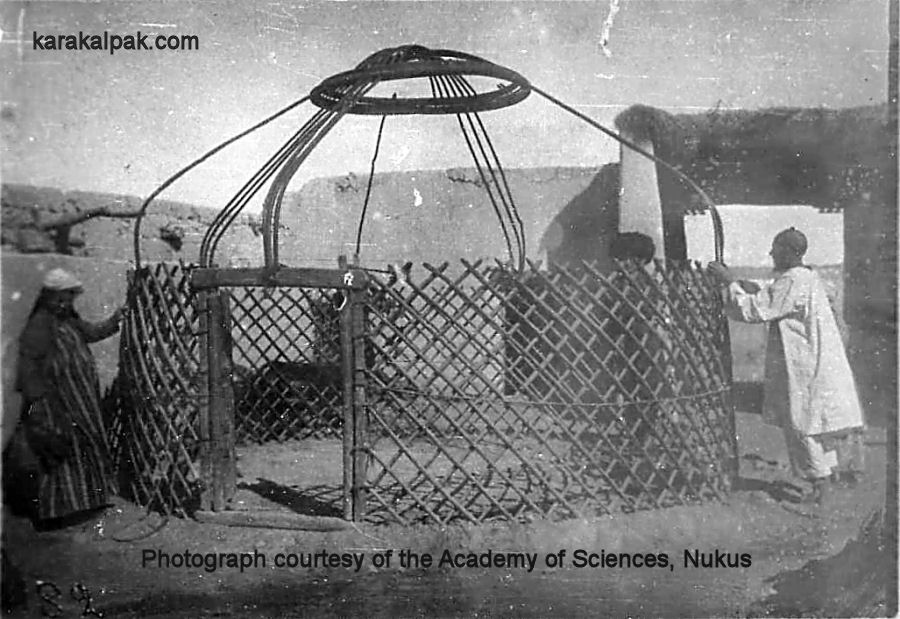
|
Yurts were traditionally assembled by women, presumably because they used to accompany the livestock to the summer
pastures while the men worked in the fields. In the past families erected the yurt themselves, generally under the
guidance of an older experienced woman. Now many families rely on the knowledge of these women to erect their yurts.
We have visited villages where the families were waiting for the expert to become available so that they could put
up their yurt. Yurts were traditionally erected on an auspicious day such as a Wednesday, but this no longer seems
to be so important. Now they are erected when the family which owns the yurt and the forewoman who is the expert
in the erection process have time available. Today most families who possess a yurt erect it only during the summer
months or, if they do keep it erected all year, then it is kept under a permanent roof, protecting the felts from
rain and snow. We have seen two instances of yurts kept under a permanent cover. Yurts are generally erected in
late May or early June, after the rains are over, and dismantled in October or November.
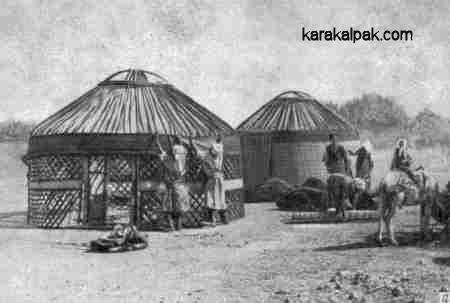
|
Erecting the Trellis Wall
In 2004 we were privileged to be invited to watch the erection of a yurt belonging to a family in one of the suburbs
of No'kis. This yurt was made in 1981 in Shımbay as were the shiy screens and esik (reed door). The forewoman was
Ulbiyke Qayıpnazarova from Taqıyatas. All of the family were lending a hand and a festive atmosphere prevailed. The
yurt was to be erected on a wooden base, about 6 to 7 meters in diameter, raised about 25 centimetres above the ground.
It was situated in a shady part of the garden next to the house.
Ulbiyke began by taking the first qanat (lattice section) which had been held in a closed position with coloured
tape – dizbe. It had a slight bend in it. She untied the cords and opened it out. She then joined the first and
second qanats together by putting a loop in the end of the dizbe over the top sticks then interlacing it down the
vertical edge of each qanat. This was put on loosely at first and then progressively tightened.
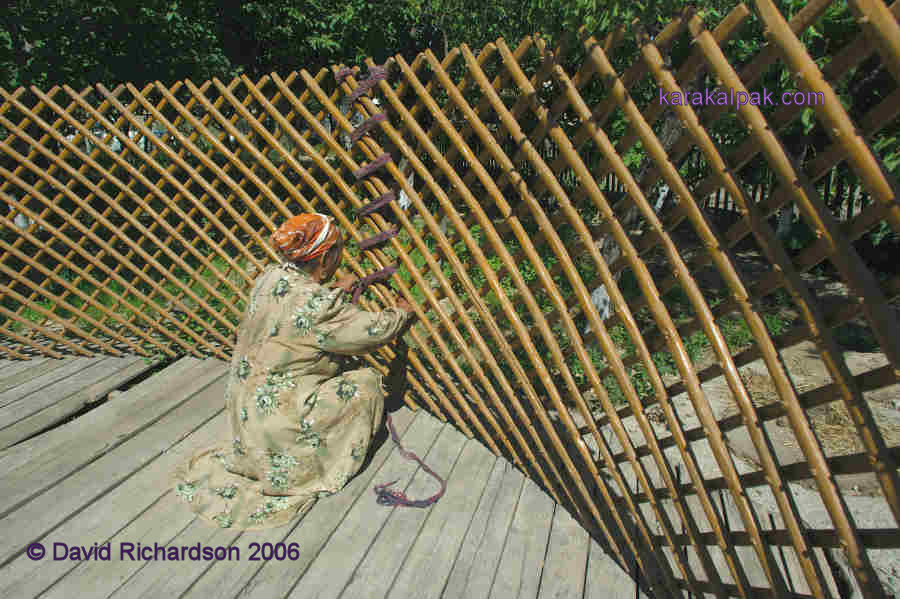
|
Each qanat was numbered so that they could be assembled in the correct order. As she linked the sections together she
constantly made adjustments to their height and width. When joined together to form a circle the qanats become known
as the kerege. When the kerege had been adjusted to the right size, she set the threshold (bosag'a) of
the door in a special hole in the wooden yurt base and levelled it with bits of stone and sticks.
Fitting the Door
In "Karakalpak Ethnography" Dr Esbergenov states that the installation of the yurt began with the door. The door and
all of its constituent parts is called the ergenek. This name is also used specifically for the two wooden door leafs
which fold inwards. The lintel is known as the man'laysha, from the word man'lay – forehead. The side struts are called
tulg'a, and the threshold is the bosag'a.
According to Dr Esbergenov, after the door is assembled the qanats are joined to it. Work should always proceed from
right to left (as viewed from the to'r inside the yurt). This process is known as "on' jaq" which literally means right side.
Ulbiyke did not follow this procedure and we are unable to say whether or not strict rules are still largely adhered to.
Most of the rest of the installation of this yurt did follow the procedure mentioned by Esbergenov.
After levelling the bosag'a she inserted the right hand door leaf (as viewed from the outside) into its slot, and then
the left hand leaf. Next came the right hand door jamb (tulg'a) followed by the left one. Then the horizontal lintel
(man'laysha) was slotted on top. She then tied the final qanat to the tulg'a on the right hand side, followed by
the left and tightened it.
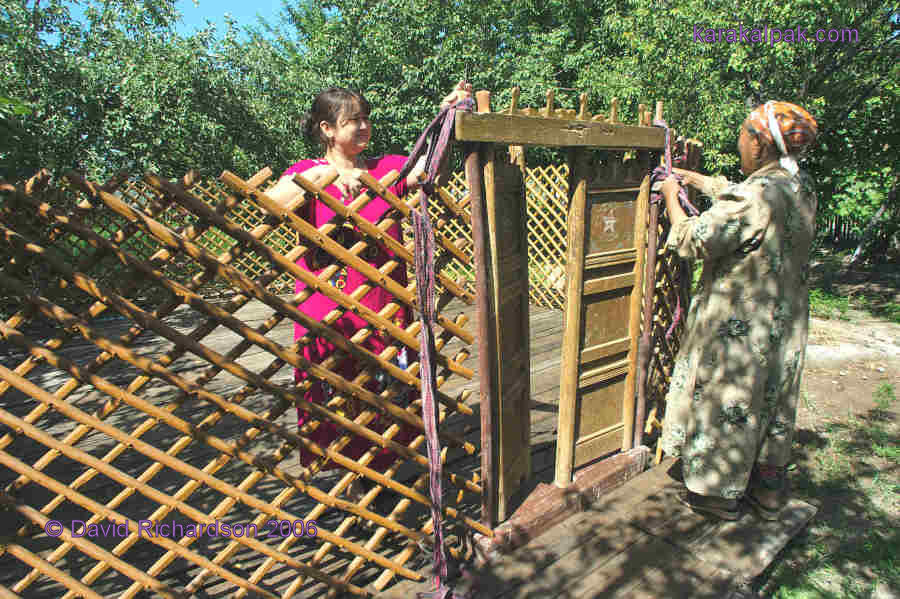
|
The ishki beldew (inner waist belt) with its pattern facing inward is put through the gap between the right hand door
leaf and the tulg'a and run around the outside of the yurt halfway up the qanats. The end goes through the gap between
the left hand door leaf and the other tulg'a and is turned back on itself by one metre. The ends of the fringe are used
to tie it to the kerege. This adds structural stability to the circular trellis wall.
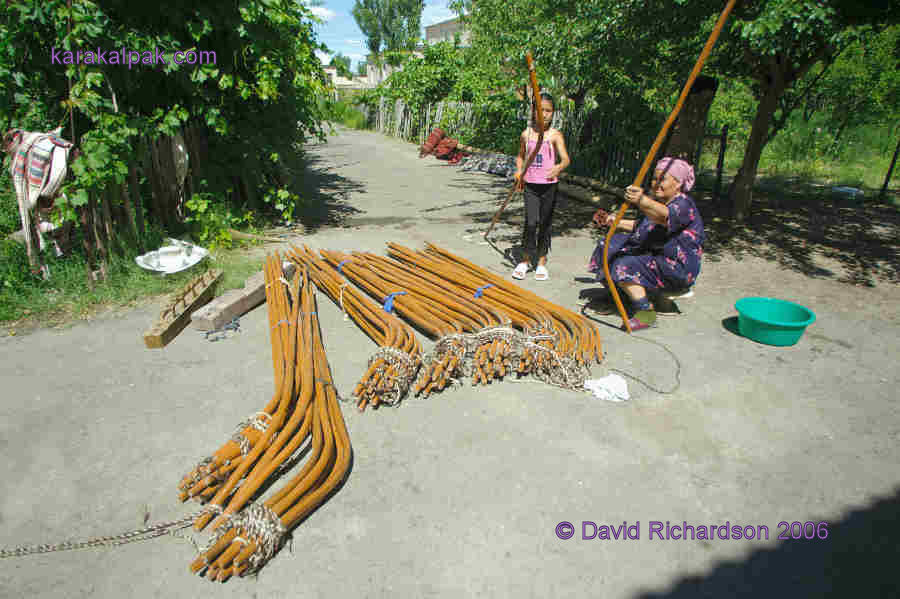
|
While this was happening the rest of the family, including the children, unpacked and washed bundles of roof struts (uwıqs).
Each had a hole at the qanat end with a cord running through it, the cord having black and white stripes with the appearance
of a barber's pole. The black ply was goat hair and the white ply was sheep's wool.
Erecting the Roof
The next stage was the lifting of the roof-wheel (shan'araq). This is the most difficult stage of the assembly since the
shan'araq is very heavy and unwieldy. Ulbiyke began by selecting four uwıqs of similar shape and tying them together
to form a lifting pole that looked a little like a hat stand. The shan'araq was placed on the wooden base in the centre. It had to
be aligned in a certain way (with the crosspiece orientated to the cardinal points according to Esbergenov). The front part is 3 centimetres
longer than the back part. The shan'araq was lifted with the pole made of uwıqs. The women stood outside of the
kerege trying to fit uwıqs into the shan'araq but they found this difficult to achieve.
They therefore rested the shan'araq on top of the door so that it was stable and reachable and then fitted some of the uwıqs
in to the holes (ko'z) in the external rim (taban). Three uwıqs were fitted into three adjacent holes in the
shan'araq and this was repeated in each of the other three quadrants of the shan'araq. With four people, each holding their bundle
of three uwıqs tied together, the shan'araq was lifted with the pole. The forewoman roughly tied her bundle above the
centre of the door then ran around to check that each of the other bundles was positioned correctly.
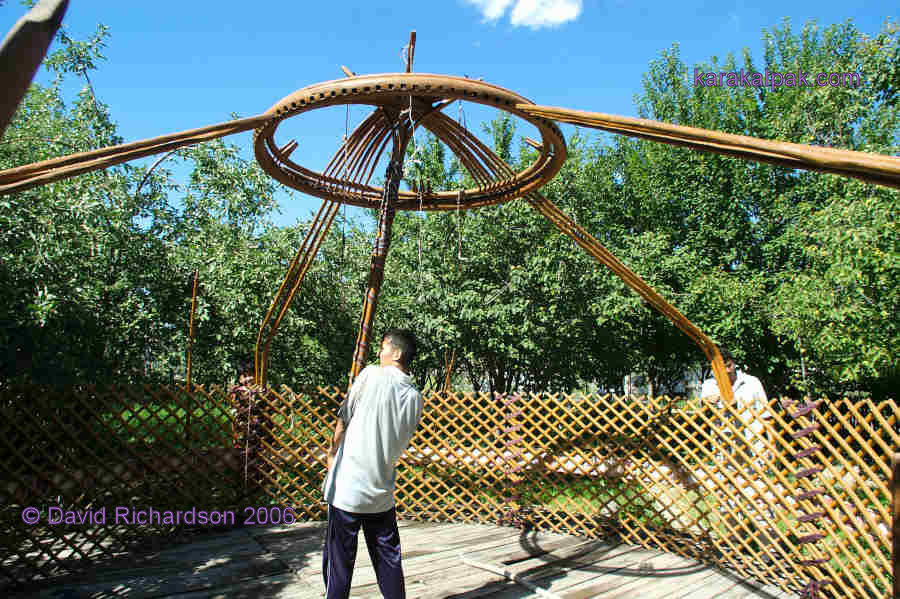
|
Now the process of tying the uwıqs to the door and the kerege could begin. Firstly two further uwıqs were fitted into the
shan'araq at positions which corresponded to each side of the door frame. They were tied on to the top of the door jambs
which protruded through the man'laysha. Then the three uwıqs that had been tied together and positioned above the door were
separated and tied to carved wooden posts on top of the man'laysha. Now each of the bundles of three uwıqs are separated and each
individual uwıq is tied to its corresponding kerege head, or keregebas as it is known. Finally each of the remaining
uwıqs are fitted into the shan'araq and are tied to the kerege.
The laces attached to the end of the uwıqs which are used to tie them to the kerege are called uwıqbaw. The sharpened upper
end of the uwıq which fits into the shan'araq is called qa'lemshe (qa'lem meaning a pencil). The bend of the
uwıq which gives the yurt roof its distinctive form is known as the iyinew (iyin, shoulder).
The method which we witnessed was very similar to that described by Esbergenov. However he also mentions a second method,
which he was unable to film, where the shan'araq can in theory be raised and attached by two people. This entails the use of
a long post (2½ to 3 metres long) with a forked end, known as a baqan. Standing in the centre of the kerege circle, the
expert would balance the shan'araq very accurately on the fork of the baqan which rested on the ground. The assistant would
then install the uwıqs. This is obviously what Ulbiyke was attempting to achieve but the weight of the shan'araq was
just too heavy to do this.
Fitting the Tent Bands
Next the qızıl basqur or red main band was unrolled. It was positioned with the pattern facing to the inside of the yurt,
at a height where the bottom edge of the basqur aligned with the joint separating the keregebas and the bottom of the
uwıqs. The upper edge of the basqur reached above the bend (iyin) of the uwıqs. As it was tightened
it compressed and constrained the whole structure.
This qızıl basqur was a particularly fine example and was wider than usual – perhaps because they had no aq basqur to go
above it. It is now rare to find a yurt with both an aq basqur and a qızıl basqur. Most only have the
qızıl basqur and in some cases even this has been replaced by a completely different tent band. In one example that we saw
the yurt owners had used a completely untraditional blue basqur.
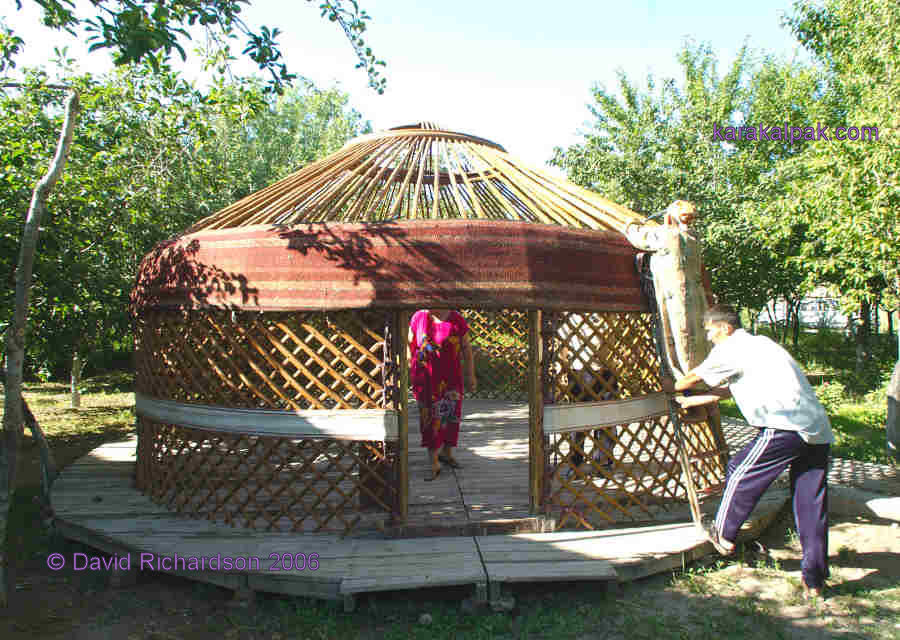
|
Narrow braid known as dizbe is then used to separate the uwıqs uniformly to even the tension and strengthen the structure.
As this is done the uwıqs start to shift about and need a lot of adjustment. The forewoman went up rickety steps on the outside of
the yurt structure to fix the dizbe – roughly at first and then tightened it. Apparently she did not have to start in a particular place.
At this point our experience differed from that described by Esbergenov. He says that the next stage is the installation of a set of
decorative woollen tassels (ayaqbaw) which hang from the shan'araq of the yurt. For some reason Ulbiyke left this until last.
However it would make more sense to do it at this stage as it is presumably easier to do before the roof felts have been added. It may simply have
been because it was getting late in the day and she wanted to get on with more of the structural components.
Traditionally the next stage would have been the installation of the aq basqur or white main belt. This is one of the crowning glories
of Karakalpak weaving. As Esbergenov points out although it is called a "main belt" this does not reflect any structural necessity. Rather it is a reflection
of the craftsmanship and skill of the mistress of the yurt. The aq basqur is normally positioned with the pattern facing inward so that
the bottom of the aq basqur sits against the top of the qızıl basqur. The band is somewhat smaller than the
diameter of the yurt and the ends align with the tulg'as, leaving a gap above the door. Unfortunately our hosts no longer possessed an
aq basqur so we were unable to see this stage for ourselves. We have however seen numerous yurts with an aq basqur in exactly
this position.
The Esikqas
If the traditional rules were being followed then the next step would have been the installation of the esikqas and
the associated pair of ishki janbaw or inner side tapes, sometimes called the iyinbaw (shoulder tapes). This was a
complex decoration positioned above the inside of the yurt entrance. The esikqas, meaning the ‘brow of the door’,
was a small rectangular piled carpet, which was positioned facing inwards, above the qızıl basqur and aligned with the
door centre. It therefore sat over the gap between the ends of the aq basqur, thus ‘completing’ the design. The end
of each ishki janbaw was sewn to the sides of the esikqas and they were suspended outwards like a garland, their
other ends being looped up to be attached to the keregebas. The ishki janbaw were narrow white cotton bands decorated
symmetrically in combination technique. They were usually decorated on their lower edges with a fringe of tassels.
Our hosts did not have a esikqas and in fact we have only seen one (a modern version) in actual use in all of
the many yurts that we have visited.
The Screens, Esik, and Decorations
Large panels of decorated felt were then sewn onto the qızıl basqur on the outside of the kerege a short distance
from each side of the door. This patterned felt is not traditional. Then thin white cotton was placed around the rest of
the outside of the kerege to keep out mosquitoes. In some places we have also recently noticed the introduction of a
layer of blue plastic fine gauge mesh, bought on the markets, to fulfil this purpose. Above the cotton lining was
a screen made of reeds (the shiy screen), formed from two parts each going from the door to the rear of the yurt. This
enabled the screen to be easily rolled back to let in more light and air. In some cases a layer of felt is used and
then a layer of shiy. This is probably more traditional, harking back to the times when yurts were used all year round.
According to Esbergenov, two layers of shiy screen could be used instead of one of felt and one of shiy.
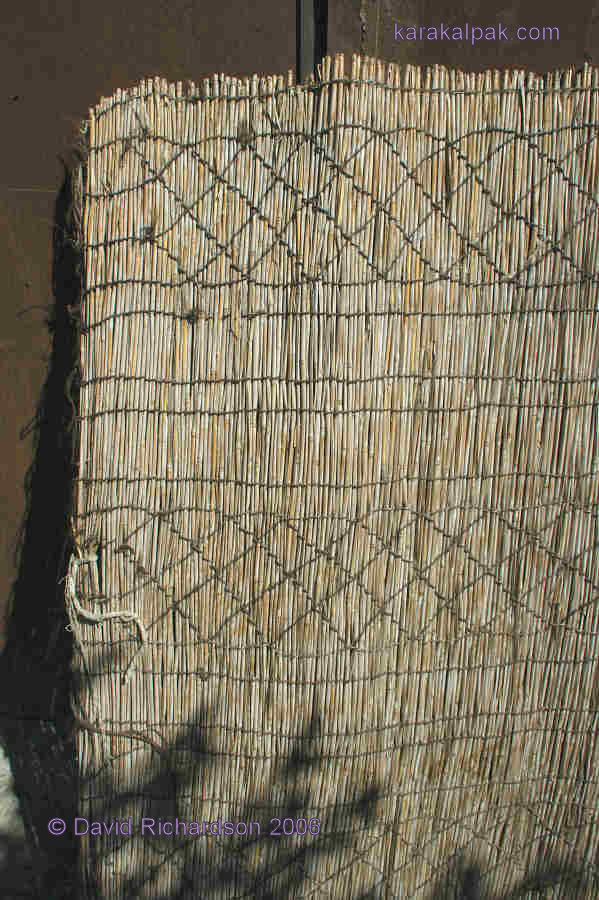
|
Next two large vertical sections of appliqué were attached to either side of the door, covering the gap left between the
door struts and the felt panels. These are known as the shiy on'ır, or breast of the shiy. In the past they were woven
in combination technique with a white cotton base and a raised pile pattern in wool. The patterns were generally pairs
of "mu'yiz" or horns and were woven in shades of brown and red.
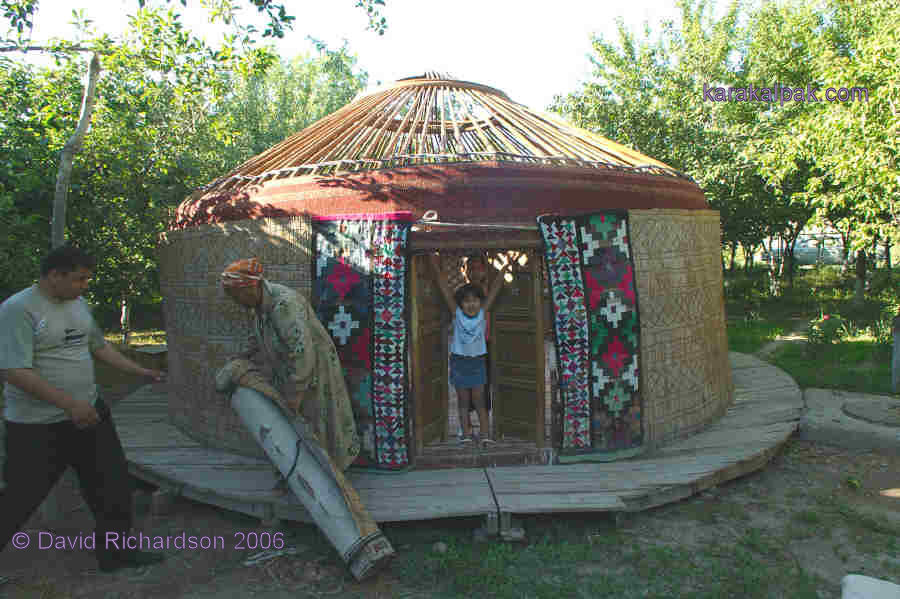
|
The screens and shiy on'ır were then held in place by a beljip (waist rope). Another name for this is the
sırtqı beldew (outer band). This reflects the fact that sometimes in the past a long white cotton band was used for
this purpose. The beljip not only holds the screens in place but is also used to stabilize the yurt in high winds. This was formerly
done by attaching short ropes from the beljip to stakes in the ground. Now it is quite common to see these stakes replaced by
a heavy car wheel hub instead.
Then the esik or reed door is added. This is rolled up above the wooden door or ergenek. It is slightly larger than the
door opening to keep the wind out. Traditionally it was decorated along its outer sides and bottom with strips of weaving
in combination technique, similar to the shiy on'ır. The vertical strips are known as shiy qayıw and the lower
horizontal strip is the suwag'ar, which means gutter. To decorate their esik our hosts had used strips from
an old tent band.
In the centre of the esik it was customary to sew a duwashıq – a triangle with its apex pointing downwards. This is seen as
amuletic and protects the entrance to the yurt. In the past pieces of paper with verses from the Qu'ran were sometimes put into a pocket in the
duwashıq, thereby fulfilling a similar role to the ha'ykel neck decoration worn by girls and women.
At this point it became too late in the evening to carry on with erecting the yurt so we returned a few days later to see the
finished construction. However it was clear from our questions that the rest of the process seemed to follow the order laid
out by Esbergenov which is as follows:
Fitting the Roof Felts
The roof felt is in three parts; a front piece (aldıngı u'zik), rear piece (artqı u'zik), and a rectangular
piece which covers the smoke-hole (tu'n'lik). All of the parts are lifted with the aid of the baqan. The front piece is put on
first. This has 12-15 centimetre-wide tent bands known as qızıl qur (literally red band, even though they may not all be red)
sewn onto it. Three bands on each side of the yurt roof are most common but we have often seen five on each side. Five bands are seen as a
sign of wealth. The felt is placed on the roof and the qur hang down through the uwıqs into the interior of the yurt. These
are then interlaced and tied to the kerege to form a net or shatırash above and behind the place of honour (the tor).
This gives a very festive appearance to the yurt. We have seen several examples of qurs with family names and dates of births or
weddings woven onto them.
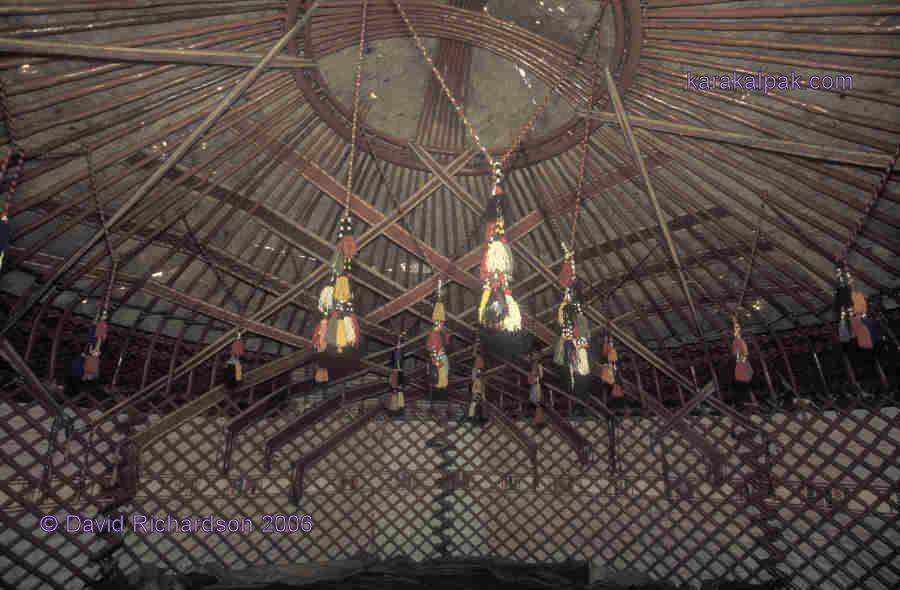
|
The rear felt is put on next. It is the same shape as the front felt and also has narrow tent bands sewn onto it, again usually
three on each side of the yurt roof. These are white cotton and are known as aq qur. They are interlaced on the outside of
the felt above the yurt door. The bottom of each band is attached to the beljip. The final decorative element is the sırtqı
janbaw or outer side belt. This is a pair of bands in combination technique on a white cotton base. The ornament is similar
to the rest of the esik. They generally have a fringe or tassels and are like a larger version of the ishki janbaw. They
are attached to the lower corner of the felt and hang as a garland. The other end goes through each tulg'a at the level of the
beljip and is attached to the kerege.
The final piece to be added is the tu'n'lik. Long ropes go from the corners of the tu'n'lik to the beljip. When they need to
open the smoke-hole they untie one of these ropes and push the felt back with the aid of the baqan.

|
Pronunciation of Karakalpak Terms
To listen to a Karakalpak pronounce any of the following words just click on the one you wish to hear. Please note that the dotless letter
'i' (ı) is pronounced 'uh'.
 |
This page was first published in June 2006. It was last updated on 6 March 2012. © David and Sue Richardson 2005 - 2015. Unless stated otherwise, all of the material on this website is the copyright of David and Sue Richardson. |